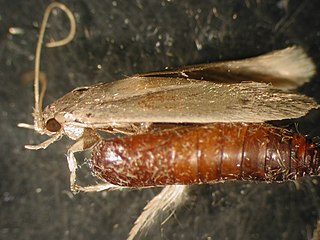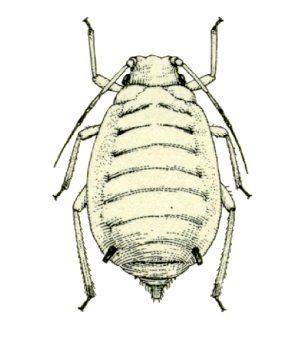Related Research Articles

Eriophyidae is a family of more than 200 genera of mites, which live as plant parasites, commonly causing galls or other damage to the plant tissues and hence known as gall mites. About 3,600 species have been described, but this is probably less than 10% of the actual number existing in this poorly researched family. They are microscopic mites and are yellow to pinkish white to purplish in color. The mites are worm like, and have only two pairs of legs. Their primary method of population spread is by wind. They affect a wide range of plants, and several are major pest species causing substantial economic damage to crops. Some species, however, are used as biological agents to control weeds and invasive plant species.

Leptosphaeria sacchari is a plant pathogenic fungus which causes a disease called ring spot on Saccharum officinarum. This species was originally described in 1890 by Kruger and in 1892 by Van Breda de Haan after it was discovered in the Dominican Republic. L. sacchari is the applied name, whereas Epicoccum sorghinum is the accepted name.
Paraburkholderia sacchari is a species of bacteria in the phylum Pseudomonadota. It was isolated in the 1990s from sugarcane crop soil, and later identified as a new bacterial species, originally named as Burkholderia sacchari. Paraburkholderia sacchari was found to be capable of creating and accumulating polyhydroxyalkanoates (PHA) by incorporating different monomers. This strain was subject of a number of genetic and bioproccess engineering studies conducted worldwide aiming to establish PHA production from different substrates, especially using agro-industrial byproducts.
Xanthomonas sacchari is a species of bacteria.

Bipolaris sacchari is a fungal plant pathogen in the family Pleosporaceae.
Heterodera sacchari, the sugarcane cyst nematode, mitotic parthenogenic sedentary endoparasitic nematode. This plant-parasitic nematode infects the roots of sugarcane, and the female nematode eventually becomes a thick-walled cyst filled with eggs. Aboveground symptoms are species specific and are similar to those caused by other Heterodera species. Symptoms include: stunted and chlorotic plants, and reduced root growth. Seedlings may be killed in heavily infested soils.

Phyllachora is a genus of fungi in the family Phyllachoraceae. An Outline of Fungi in 2020 listed up to 1513 species.

Opogona sacchari, the banana moth, is a moth of the family Tineidae. The species was first described by Wenceslas Bojer in 1856. It is native to the humid tropical and subtropical regions of sub-Saharan Africa, where it is also found in Madagascar, Mauritius, Réunion, Rodrigues Island, the Seychelles and St. Helena. It was first reported from the Canary Islands in the 1920s. In the 1970s, it was introduced into Brazil and Central America, and also appeared in Europe. It has been reported from Florida since 1986.
Euseius sacchari is a species of mite in the family Phytoseiidae.
Oligonychus sacchari, the sugarcane mite, yellow mite or sugarcane yellow mite, is a species of mite.
Gluconacetobacter sacchari is a species of acetic acid bacteria first isolated from the leaf sheath of sugar cane and from the pink sugar-cane mealy bug on sugar cane growing in Queensland and northern New South Wales. The type strain of this species is strain SRI 1794T. It is notable for its production of bacterial cellulose and for being an endophyte in sugar cane.

The sugarcane aphid,, is an aphid in the superfamily Aphidoidea in the order Hemiptera. It is a true bug and sucks sap from plants. It is mostly found in Saccharum and Sorghum species. The species primarily reproduces via parthenogenesis, although sexual morphs have been discovered in China, Japan, and Mexico - in China the eggs overwinter in the host Miscanthus sacchariflorus.
Alicyclobacillus contaminans is a species of Gram positive, strictly aerobic, bacterium. The bacteria are acidophilic and produce endospores. It was first isolated during a survey from both orange juice, and soil in Fuji City, Japan. The species was first described in 2007, and the name is derived from the Latin contaminans (contaminating).
Alicyclobacillus fastidiosus is a species of Gram positive, strictly aerobic, bacterium. The bacteria are acidophilic and produce endospores. It was first isolated from apple juice. The species was first described in 2007, and the name refers to the fastidious nature of the organism; the bacteria would start to die off after 7 days when plated on typical agar for isolating Alicyclobacillus. Additionally, the species produced fewer spores than other members of its genus, and took much longer to produce the spores.
Alicyclobacillus kakegawensis is a species of Gram positive, strictly aerobic, bacterium. The bacteria are acidophilic and produce endospores. It was first isolated from soil in Kakegawa, Japan. The species was first described in 2007, and the named after the city from which it was first isolated.
Alicyclobacillus macrosporangiidus is a species of Gram positive, strictly aerobic, bacterium. The bacteria are acidophilic and produce endospores. It was first isolated from soil in a crop field in Fujieda, Japan. The species was first described in 2007, and the name is derived from the Latin macros (big) and sporangium (sporangia), referring to the large spores produced by the organism.
Alicyclobacillus sacchari is a species of Gram positive, strictly aerobic, bacterium. The bacteria are acidophilic and produce endospores. It was first isolated from liquid sugar. The species was first described in 2007, and the name is derived from the Latin sacchari.
Alicyclobacillus shizuokensis is a species of Gram positive, strictly aerobic, bacterium. The bacteria are acidophilic and produce endospores. It was first isolated from soil in a crop field in Shizuoka, Japan. The species was first described in 2007, and the name refers to the city from which it was first isolated.
CandidatusPhytoplasma sacchari is a species of phytoplasma pathogen associated with sugarcane grassy shoot disease (SCGS). This SCGS phytoplasma belongs to the Rice Yellow Dwarf (RYD) group.
Pseudaspidimerus trinotatus, is a species of lady beetle found in India, Sri Lanka and Myanmar.
References
- ↑ "GSD Species Synonymy: Dimeriella sacchari (Breda de Haan) Hansf. ex E.V. Abbott". Species Fungorum. CAB International. Retrieved 2014-05-31.
- ↑ Koike H. (1988). Sugar-cane Diseases: A Guide for Field Identification. Food & Agriculture Organization. p. 16. ISBN 978-92-5-102534-5.